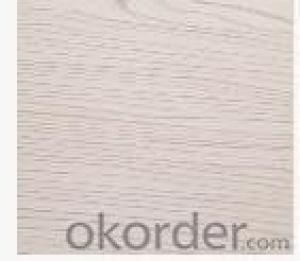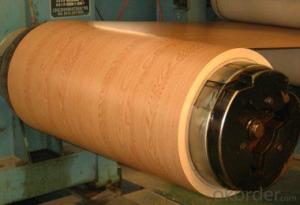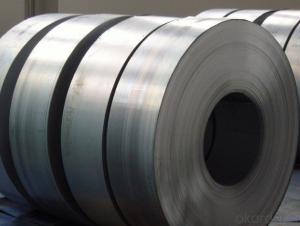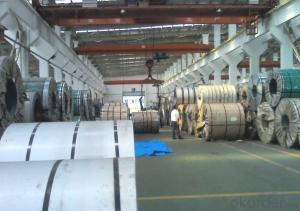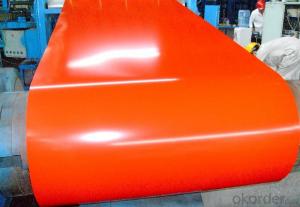Wood pattern PPGI PPGL Prepainted steel coils
- Loading Port:
- Shanghai
- Payment Terms:
- TT OR LC
- Min Order Qty:
- 50 m.t.
- Supply Capability:
- 100000 m.t./month
OKorder Service Pledge
OKorder Financial Service
You Might Also Like
colour coated steel
painting colour steel , zinc coated steel , lead coated steel
Standard: | AISI,ASTM,BS,DIN,GB,JIS | Grade: | DX51D,SGCC,SPCC,CGCC | Thickness: | 0.17-1.5mm |
Place of Origin: | Taian China (Mainland) | Brand Name: | HengJi | Model Number: | HJ |
Type: | Steel Coil | Technique: | Cold Rolled | Surface Treatment: | RAL color cremated, oiled, skin passed |
Application: |
building metal roofing components,house appliance | Width: | 914-1250mm | Length: | customized |
price: | favorable price | Our Customers | Steel force, Stemcor, Duferco, Samsung , G&G,Hyosung,CNBM |
Packaging & Delivery
Packaging Detail: | standard export packing or customized |
Delivery Detail: | 15 days after prepayment |
Specifications:
galvanized steel coil:
1.Thickness:0.17mm-1.5mm
2.Zinc coated:40g-275g/2
3.Standard:dx51d+z,sgcc
We manufacture Galvanized Steel Coils,Pre-painted Galvanized Steel Coils , etc
Prepainted steel coil features:
1. Zinc coating :40-120g(as reauired)
2. thickness:0.17-1.2mm
3. width:914-1250mm(900mm,1215mm,1250mm,1000mm the most common)
4. coil id:508m610mm
5. coil weight: 3-12(as required)
6. surface treatment:RAL color
Galvanized steel coil features:
1. Zinc coating :40-275g( as required)
2. thickness:0.17-1.2mm
3. width:914-1250mm(900mm,1215mm,1250mm,1000mm the most common)
4. coil id:508m610mm
5. coil weight: 3-12(as required)
6. surface treatment: cremated, oiled, skin passed
7. Spangle: regular,small, zero
8.Application: With excellent cold bending molded manufacturablity, good decoration effect, strong anti-corrosion ability, galvanized steel coils and sheets are also pollution-free and easily recycled. Accordingly, they can be used as final products and basic plates of color coated steel coils and widely applied in construction, home appliances, decoration, ect.
Product name | steel coil,galvanized steel,galvanized steel coil |
Material | DX51D, SGCC, SPCC, CGCC, DX51D |
Normal thickness | 0.17-1.2mm |
Normal width | 900mm,914mm, 1000mm, 1200mm, 1220mm, 1250mm |
Coil weight | 3-12ns |
Certificate | BV & SGS |
Original | Shandong,China |
Payment terms | L/C or T/T |
Delivery time | within 15 ~ 25 days after 30% prepayment |
- Q:What are steel strips?
- Steel strips are thin, flat pieces of steel that are commonly used in various industries for applications such as construction, automotive manufacturing, and household appliances. They are typically produced through a process called hot rolling, where steel is heated and passed through a series of rollers to achieve the desired thickness and shape. Steel strips are known for their strength, durability, and versatility, making them essential components in many different products and structures.
- Q:Are steel strips suitable for the production of heat exchangers?
- Yes, steel strips are suitable for the production of heat exchangers. Steel is a durable and highly heat-resistant material that can effectively transfer heat between fluids. Steel strips are often used to construct the tubes or fins in heat exchangers, providing excellent thermal conductivity and ensuring efficient heat transfer.
- Q:What are the different types of steel strip coils?
- There are several different types of steel strip coils available, each with its own unique properties and applications. Some of the most common types include: 1. Hot-rolled steel strip coils: These coils are produced through a hot rolling process, where the steel is heated above its recrystallization temperature and then passed through a series of rollers to achieve the desired thickness. Hot-rolled steel strip coils are commonly used in construction, automotive, and general engineering applications. 2. Cold-rolled steel strip coils: In contrast to hot-rolled coils, cold-rolled steel strip coils are produced by rolling the steel at room temperature. This process results in a smoother surface finish and tighter dimensional tolerances. Cold-rolled steel strip coils are often used in applications that require high precision and superior surface quality, such as appliances, electronic components, and automotive parts. 3. Galvanized steel strip coils: Galvanization is a process where a layer of zinc is applied to the surface of the steel to protect it from corrosion. Galvanized steel strip coils are commonly used in outdoor applications or environments exposed to moisture, such as roofing, fencing, and electrical conduits. 4. Stainless steel strip coils: Stainless steel is an alloy that contains a minimum of 10.5% chromium, which provides excellent corrosion resistance. Stainless steel strip coils are highly versatile and are used in various industries, including food processing, chemical, and medical equipment manufacturing. They are available in different grades, each with specific properties suited for different applications. 5. Electrical steel strip coils: Electrical steel, also known as silicon steel or transformer steel, is specifically designed for use in electrical applications. It has low electrical conductivity and high magnetic permeability, making it ideal for manufacturing transformers, motors, and generators. These are just a few examples of the different types of steel strip coils available. Each type has its own unique properties that make it suitable for specific applications, and the choice of the appropriate type depends on factors such as the desired strength, corrosion resistance, surface finish, and electrical conductivity.
- Q:Can steel strips be used in the production of heat exchangers?
- Yes, steel strips can be used in the production of heat exchangers. Steel is a commonly used material in heat exchangers due to its high strength, durability, and excellent thermal conductivity. Steel strips can be formed and welded into various shapes and sizes to create the necessary components of a heat exchanger, such as tubes or fins, which help facilitate the efficient transfer of heat between fluids.
- Q:How are steel strips used in the production of industrial machinery?
- Steel strips are used in the production of industrial machinery for various purposes such as forming structural components, manufacturing gears, shafts, and brackets, and providing reinforcement and support to ensure durability and strength in the equipment.
- Q:Are steel strips suitable for the manufacturing of electrical motors?
- Yes, steel strips are suitable for the manufacturing of electrical motors. Steel strips provide excellent magnetic properties, such as high permeability and low core loss, which are essential for efficient and reliable motor operation. Additionally, steel strips offer superior mechanical strength and durability, making them ideal for withstanding the stresses and vibrations associated with motor operation.
- Q:Are steel strips suitable for precision applications?
- Yes, steel strips are suitable for precision applications. Steel strips offer high strength, durability, and excellent dimensional stability, which are essential requirements for precision applications. Additionally, steel strips can be manufactured with tight tolerances and are readily available in various thicknesses and widths, making them highly versatile for precision applications in industries such as automotive, aerospace, and electronics.
- Q:Can steel strips be used for making electrical connectors in power distribution systems?
- Yes, steel strips can be used for making electrical connectors in power distribution systems. Steel strips provide several advantages for this application. Firstly, steel is a highly conductive material, making it suitable for carrying electrical current. It has a low resistance, which ensures minimal power loss during transmission and distribution. Steel also has good mechanical properties, allowing it to withstand the stresses and strains experienced in power distribution systems. Additionally, steel strips can be easily formed into various shapes and sizes, making them versatile for designing different types of connectors. They can be bent, punched, or welded to create specific connection points for electrical cables. Steel strips can also be coated with a protective layer, such as tin or nickel, to improve their corrosion resistance and electrical conductivity. Furthermore, steel is a durable and long-lasting material, capable of withstanding harsh environmental conditions and providing reliable electrical connections over an extended period. This durability is crucial in power distribution systems, where connectors must maintain their integrity and conductivity under high voltage and current levels. However, it is important to note that steel strips may not be suitable for all types of electrical connectors. In certain applications, where higher electrical conductivity or specific mechanical properties are required, other materials like copper or aluminum may be preferred. The choice of material for electrical connectors depends on various factors such as the specific requirements of the power distribution system, cost considerations, and industry standards.
- Q:What's the difference between strip 235 and 235b?
- Q235 is Q235a, Q235 material according to the sulphur and phosphorus content from high to low is divided into ABCD four grades, grade a sulfur phosphorus was the highest relative performance (welding, plasticity) is the worst, D performance is the highest, the lowest content of parathion
- Q:What are the main factors affecting the fatigue resistance of steel strips?
- The main factors affecting the fatigue resistance of steel strips include the material's composition, surface condition, and the presence of any defects or stress concentrations. Other factors such as the frequency and magnitude of cyclic loading, temperature, and environmental conditions can also influence the fatigue resistance. Additionally, the manufacturing process and any subsequent treatments or coatings applied to the steel strips can affect their fatigue performance.
1. Manufacturer Overview |
|
|---|---|
| Location | |
| Year Established | |
| Annual Output Value | |
| Main Markets | |
| Company Certifications | |
2. Manufacturer Certificates |
|
|---|---|
| a) Certification Name | |
| Range | |
| Reference | |
| Validity Period | |
3. Manufacturer Capability |
|
|---|---|
| a)Trade Capacity | |
| Nearest Port | |
| Export Percentage | |
| No.of Employees in Trade Department | |
| Language Spoken: | |
| b)Factory Information | |
| Factory Size: | |
| No. of Production Lines | |
| Contract Manufacturing | |
| Product Price Range | |
Send your message to us
Wood pattern PPGI PPGL Prepainted steel coils
- Loading Port:
- Shanghai
- Payment Terms:
- TT OR LC
- Min Order Qty:
- 50 m.t.
- Supply Capability:
- 100000 m.t./month
OKorder Service Pledge
OKorder Financial Service
Similar products
New products
Hot products
Related keywords
